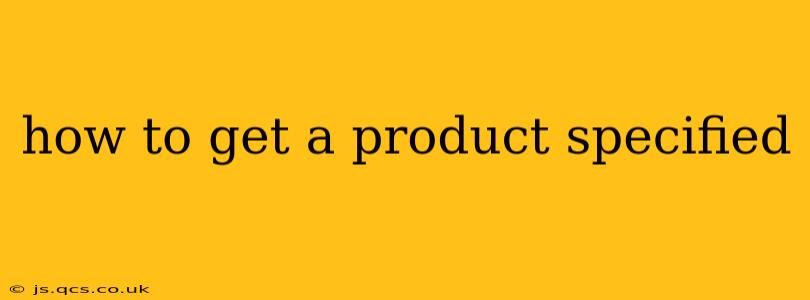How to Get a Product Specified: A Comprehensive Guide
Getting a product specified correctly is crucial for ensuring you receive exactly what you need, whether for a construction project, a manufacturing process, or even a simple purchase. This process involves clearly defining your requirements, communicating them effectively, and verifying the final product against those specifications. This guide will walk you through the entire process, answering common questions along the way.
What Does "Product Specification" Mean?
Product specification refers to the detailed description of a product's characteristics, including its materials, dimensions, performance capabilities, and quality standards. It's a formal document that serves as a blueprint for the product's design, manufacturing, and testing. A well-written specification leaves no room for ambiguity, ensuring everyone involved understands the exact requirements.
How Do I Create a Product Specification?
Creating a comprehensive product specification requires a structured approach:
-
Identify Your Needs: Begin by clearly defining the purpose of the product and its intended use. What problem does it solve? What are its key functions?
-
Gather Requirements: List all the necessary features, functionalities, and performance characteristics. Consider factors like dimensions, weight, materials, durability, safety, and aesthetics.
-
Define Tolerances: Specify acceptable variations in dimensions, performance, and other characteristics. This helps avoid misunderstandings and ensures the product meets minimum quality standards.
-
Choose Appropriate Standards: If applicable, reference relevant industry standards or regulations to ensure compliance and consistency.
-
Document Everything: Compile all the information into a clear, concise, and well-organized document. Use tables, diagrams, and other visual aids to enhance clarity.
-
Review and Revise: Before finalizing the specification, have it reviewed by stakeholders to ensure accuracy and completeness.
What Information Should Be Included in a Product Specification?
A complete product specification typically includes:
- Product Identification: A unique name or identifier for the product.
- Purpose and Intended Use: A clear description of the product's function and application.
- Functional Requirements: A detailed list of the product's capabilities and performance characteristics.
- Physical Requirements: Specifications for dimensions, weight, materials, and appearance.
- Performance Requirements: Metrics for speed, efficiency, accuracy, and other performance aspects.
- Quality Requirements: Standards for materials, workmanship, and testing procedures.
- Safety Requirements: Compliance with relevant safety regulations and standards.
- Environmental Requirements: Considerations for environmental impact and sustainability.
- Packaging and Delivery Requirements: Specifications for packaging, labeling, and shipping.
How Do I Communicate My Product Specification Effectively?
Clear communication is vital to ensure the product meets your specifications.
- Use Clear and Concise Language: Avoid jargon and technical terms that may not be understood by all stakeholders.
- Use Visual Aids: Diagrams, drawings, and photographs can enhance understanding.
- Provide Examples: If possible, provide examples of similar products that meet your requirements.
- Seek Feedback: Regularly communicate with the supplier or manufacturer to clarify any ambiguities and address any concerns.
How Do I Verify That the Final Product Meets the Specification?
Once the product is manufactured or delivered, it's essential to verify that it meets the specified requirements. This typically involves:
- Inspection: A visual inspection to check for defects and ensure the product conforms to the physical specifications.
- Testing: Performance testing to verify that the product meets the functional and performance requirements.
- Documentation: Maintain detailed records of the inspection and testing procedures and their results.
What Happens If the Product Doesn't Meet the Specification?
If the product doesn't meet the specification, you should immediately communicate this to the supplier or manufacturer. Clearly outline the discrepancies and work together to find a solution, whether it's rework, replacement, or a negotiated settlement.
By following these steps and addressing the common questions surrounding product specification, you can significantly improve the chances of receiving a product that precisely meets your needs and expectations. Remember, thorough planning and clear communication are key to success.
